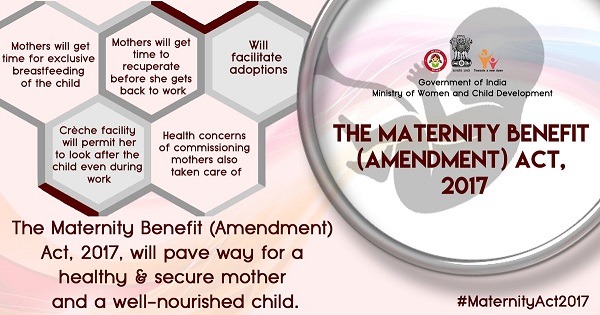Maternity Benefit (Amendment) Act, 2017
The amendments to the Maternity Benefit Act, which were introduced this year, in particular the provision of 26 weeks of paid maternity leave and the mandatory creche facility, are path-breaking, but there are concerns over their feasibility.
- applicable to all establishments employing 10 or more persons
- maternity benefit of 26 weeks (earlier 12)
- can be availed before 8 weeks from the date of expected delivery (earlier 6)
- woman who has two or more children, the maternity benefit will continue to be 12 weeks, which cannot be availed before 6 weeks from the date of the expected delivery
- 12 weeks of maternity leave to –
- a woman who legally adopts a child below three months of age
- a commissioning mother (biological mother who uses her egg to create an embryo implanted in another woman)
- an employer may permit a woman to work from home even after the leave period
- 50 or more employees – mandatory to provide creche facilities within a prescribed distance
- Informing women employees of the right to maternity leave at the time of her appointment
Pros
- maternity leave of 26 weeks exceeds ILO’s minimum standard of 14 weeks
- will help 18 lakh women workforce in organised sector
- help women devote time to bond with their babies
- breastfeed leading to enhanced nutrition & immunity – lower IMR
- increase the women’s labour force participation rate in India
Cons
- perpetuates gender role stereotypes as is silent on paternity leave issue
- recognizes mothers as primary care giver and ignores role of father in childcare
- ignores single father or transgender who might want to adopt a child
- may deter employers from hiring female work force, perpetuating gender in employment
- may lead employers to pay men more than the women due to different work conditions – weakens DPSP
- Smaller companies may struggle to meet the increased financial burden
- provisions are limited to the organized sector, thus benefitting 20.5 % of working women
- women may lose touch with work-related developments & will lag behind their colleagues after resumption
Why Maternity leaves are Important?
- Six month of breastfeeding is important for the infant to develop immunity against diseases – lower IMR
- Article 42 of the Constitution guarantees maternity benefits to all working women
- WHO emphasize that a baby needs to be nursed by its mother for a minimum of six months
Way Forward
- To ensure equality amendment should extend to both parents – can share leaves as done in other countries
- amendment should also extend to women working in unorganized sector
- Follow Singapore Model – half reimbursement by employer & half by government
- After resumption, employer should offer light workload, flexible working hours, & work from home facility for the first few weeks. This will give them time to pick the pace without getting discouraged.
Paternity leave
- Paid or unpaid leave given to male employees when they become a parent
- Public sector grants 15 days of paternity leave while there is no law on paternity leave in private sector
Pros
- Involvement of both parents crucial in the wake of increasing number of nuclear families
- Would lead to a gender balanced approach towards care giving and unpaid work
- May reduce women taking career break due to pregnancy
Cons
- Could be misused by the employees
- Embarrassment associated with availing paternity leave for men
- Lack of awareness and understanding of the importance of paternity leave





1 comment
very good effort